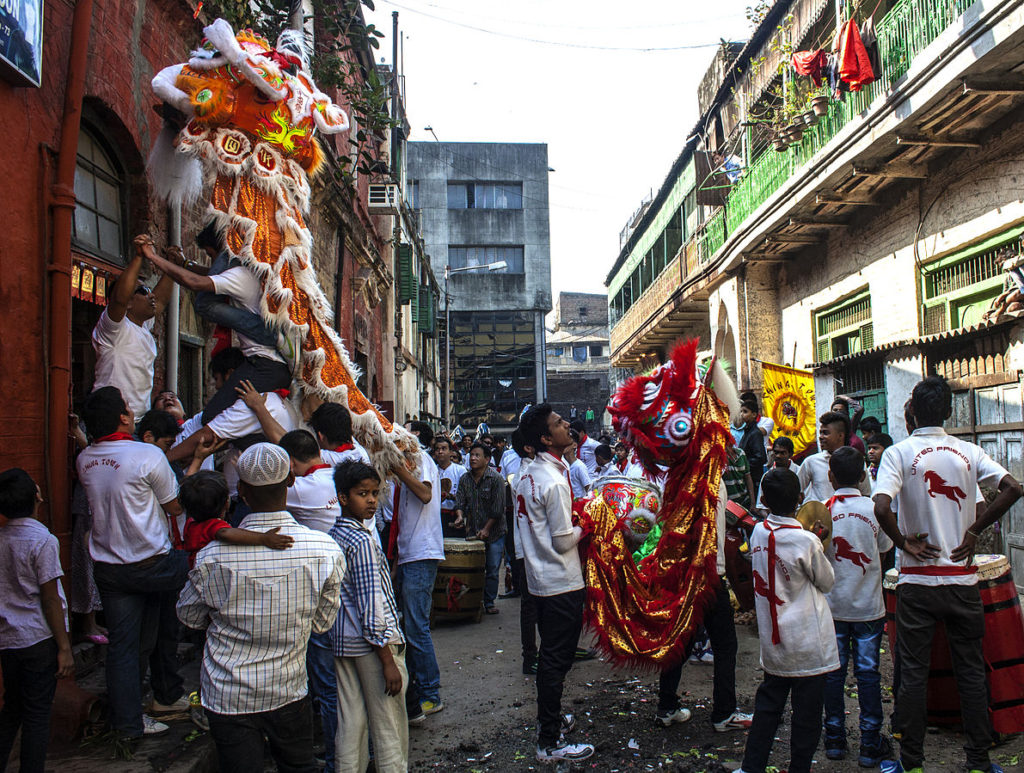
If we are to preserve culture, we must continue to create it.’
~Johan Huizinga
In East Kolkata a Chinese enclave or as the Bengalis call it Cheena Para exists. This enclave is home to around 5,000 Chinese people who consider themselves as Chinese Indians. Kolkata is India’s only city that has a Chinatown.
India has enjoyed a prolonged history of commercial and cultural links with mainland China. Consequently, there are records of large-scale migration in the 18th century primarily from provinces like Fujian, Guangdong, and Canton. The earliest accounts of such migrations consist of an eyewitness and a maritime record from the 1820s. The motives for migrating were many; Calcutta, depicted as ‘the city of dreadful nights’ by Kipling, had a conducive market for Chinese products such as tea, silk, and porcelain. The Chinese were also skilled opium traders. The central administration in China was quickly debilitating and the economy was rapidly declining. There were more substantial business prospects with the Portuguese and the British in India. Moreover, the Chinese had acquired a sense of security and livelihood in Calcutta.
According to oral history records and documents, the first-ever Chinese immigrant in India was Ah Chew who belonged to the Guangdong province. An entry in the Bengal District Gazetteers: 24 Parganas, affirms that Tong Ah Chew was granted a portion of land by Governor-General Warren Hastings of the East India Company, where he established a sugar manufacturing mill. Even though the sugar mill was closed down after his demise, many Chinese workers relocated to Kolkata and were later accompanied by others from their homeland.
The Hakka Chinese migrated to India during the 1850s, due to the Punti-Hakka Wars (1855–67) and the Taiping Rebellion (1850–64). They initially settled in the Old Chinatown and in 1910 they established the first Chinese-run tannery in Tangra (East Kolkata). It grew profitable during World War I, due to an increased wartime demand for leather. Besides, working with leather became their principal occupation since Upper-caste Hindus were abhorred at the thought of even touching a dead cow’s hide. The Old Chinatown saw a massive influx of refugees from South China during the Japanese Invasion, Second World War, and the civil war between Kuomintang and Mao’s Communists. However, the Chinese community started to undergo a disintegration during the Sino-Indian war of 1962. During the war, many were deported to China, or transferred to the internment camp at Deoli in Rajasthan.
The Hakkas quickly adopted the Bengali palate and started using indigenous ingredients. The Chinese restaurants at the enclave now hires South-Indian or Nepali cooks who are supervised by middle-aged Hakka people. The Hakkas were originally cobblers and leather workers, hence, it is fascinating how they turned their profession to cooking, ultimately being the ones who invented the Indo-Chinese cuisine.
Several Chinese people are striving to preserve and continue their traditions. One such individual is R.T Chan who publishes the only daily Chinese newspaper in Mandarin in India. In Chinatown one can observe an amalgamation of cultures as one walks down the narrow streets lined with drains filled with chemicals from the tanneries. There is a temple dedicated to goddess Kali in this enclave. The most astonishing aspect of the idol is its facial features. The goddess’s face resembles the face of a Chinese woman; hence, it is also known as the Chinese Kali Mandir.
Today, the Chinese community comprises of only middle-aged people as the younger generation is receiving better opportunities and prospects abroad. Their livelihood is dependent on these leather tanneries and Chinese restaurants. Nonetheless, an anti-pollution order to shut down these tanneries feels like a death sentence to this already crumbling community. Paul Chung, a member of the Indian Chinese Association feels that such government orders can entirely change the character of the enclave for eternity.
Unfortunately, the people of Chinatown have been caught amidst COVID 19 and the violent clash at the Galwan valley and are being increasingly ostracised by society. Nevertheless, the hardest blow to their security, community and business struck when some politicians urged the masses to boycott all Chinese goods, even the cuisine. According to some residents, Chinatown resembled a ghost town after the speech. Now they are constantly living in terror and are petrified to leave their houses. These innocent people have nowhere to go and should not be deported to China. These individuals consider themselves as Indian citizens, possessing all the documents required to allow them to vote; yet, due to the escalating tensions between India and China, they are the ones who are being disgraced by society.


